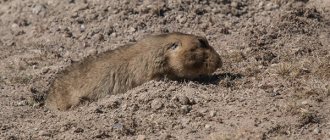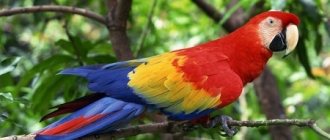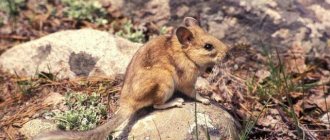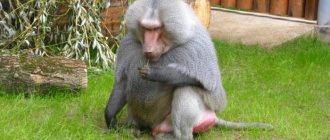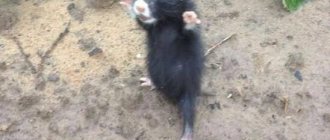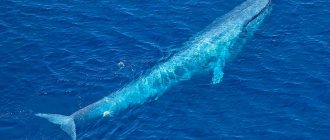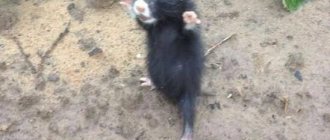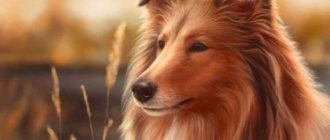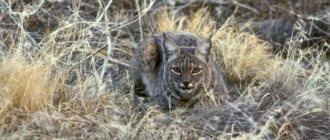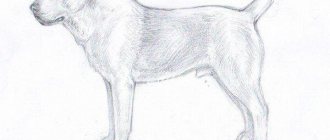By what characteristics is a cat classified as wild?
Non-domesticated felines are distributed throughout the world. They are all ideal predators. No other mammals on earth can sneak up, guard, and grab so skillfully.
What, then, is the difference between domestic pets and free savages? A wild cat differs from a domestic cat in the following features:
Temminka
- Color. A pattern in the form of stripes or spots helps animals remain unnoticed where they live. Desert inhabitants are close in color to sand, steppe inhabitants are close to dry grass.
- Size. Forest and steppe "pussies" differ from domestic purrs in height and body length, because they need strength to hunt.
- Short intestine. Their intestines are short because they need to move quickly, and a full belly prevents this.
- Length of limbs. Forest and steppe animals are forced to run a lot and quickly, domestic cats move little, which is why the latter have shorter legs. Savages have 5 toes on their front paws and 4 on their hind paws.
- Temper. Wild cats are distinguished by their ferocity and uncontrollability. They are nocturnal, try to avoid meeting people, and can attack him.
Cheetah An adult cat living freely in the forest or steppe is almost impossible to tame. You can only make a pet a small kitten that came to people as a baby, but in this case you should not forget that this is a predatory animal.
Clouded leopard
The oldest species of wild cat survives in the tropical and subtropical regions of Southeast Asia.
The beautiful animals are distinguished by their amazing marbled-smoky color and are the ancestors of all large cats. The dimensions of clouded leopards are 1.5-2 m with a weight of no more than 20 kg, while the tail is almost half of the entire length of the body. It is interesting that, according to physiological characteristics, the leopard also contains characteristics of small representatives of the family. For example, an animal can purr like a domestic kitten. Possessing a flexible and strong body, the animal easily moves through trees, and with the help of sharp claws and a long, elastic tail it can freely clasp a trunk. Today the number of animals is no more than 10 thousand individuals.
Reproduction and care of offspring
Steppe cats prefer to lead a solitary lifestyle . Each male has his own territory, which he jealously guards from the invasion of other cats. The females also help guard the territory, settling not far from the males, and, if necessary, join their efforts to drive away the strangers.
The mating season for these animals lasts from January to March. Interestingly, unlike domestic cats, steppe cats are rather quiet creatures and try not to attract attention by screaming and meowing. Only during the mating season, these cats can make different sounds, from loud meows to snorting and growling.
A female ready for mating can be courted by several males, and she chooses the largest and healthiest male as the father for future offspring. After courtship and mating, the male leaves the female and does not take any part in raising future offspring.
The pregnancy of a steppe cat lasts from two to two and a half months. As a nest, the female builds a hole or hollow in a tree. Young females give birth to one or two babies, while more mature individuals have up to six kittens in a litter. But most often, steppe cats give birth to no more than three babies. Kittens are born blind and helpless, and for the first six months they are completely dependent on the care of their mother.
Steppe cats have a highly developed maternal instinct, and they never abandon their offspring. Two weeks after birth, the kittens' eyes open, and a month later, the babies are already covered with fur and look like a smaller copy of their parents.
The female feeds the cubs with milk for more than two months, and only after this period has passed does she begin to accustom the kittens to adult food. First, the steppe cat brings the kids small rodents caught during the hunt. As the kittens grow older, the female brings live prey to her “nest,” teaching the cubs to hunt on their own.
For two to three months, steppe cat kittens do not leave the parental den; after this period, the cubs begin to go hunting with their mother. The steppe cat takes care of its babies for six to seven months, then the matured kittens begin an independent life. Sexual maturity of steppe cats occurs a year after birth, but usually, males are ready to breed only at the age of two.
Lions
The lion belongs to the cat family. He is rightfully considered the king of beasts. This predator is second in size only to some species of tigers. The diet of these formidable mammals depends on their habitat. But they all hunt mainly large herbivores. The victims of African lions are often zebras, buffalos and antelopes. Individuals living in Asia hunt wild boars and deer.
Lions are social animals. They unite in small groups, which include several females and one male leader. It is noteworthy that food production falls entirely on the shoulders of females. Males themselves rarely hunt.
Each pride has its own clear territory, its protection and security is carried out by the leader.
Modern classification of wild cats
Once upon a time, all cats were divided into three subgroups. Nowadays, zoologists divide wild cat families into large and small cats. Previously, the cheetah subfamily was distinguished, but then, as a result of a study of the DNA of these animals, it was determined that they are close to small cats. Each subfamily contains several genera, which differ in habitat, size, color, and habits.
Subfamily of small cats
This group of mammals is divided into 12 genera and almost 30 different species. A distinctive feature of representatives of this subfamily is the ability to rumble when inhaling and exhaling. Representatives of some species can reach two meters in length.
Small cats have enviable eyesight, excellent hearing and a good sense of smell. These predators feed on small mammals, such as rodents, and birds.
Cheetah and caracal
Cheetahs are the fastest cats in the world: they can reach speeds of up to 120 km/h. True, an animal can run so fast for only a couple of minutes. This type of cat has a long body - about 140 cm. The color is sandy with characteristic spots.
Caracal
Caracal, or, as it is also called, steppe lynx. The body length of this animal can reach up to 82 cm. Distinctive features of the caracal are the presence of tassels on the ears, as well as hair brushes on the paws. It is very agile and can jump deftly.
The fastest insects
And now let’s move on to the most unpleasant part, insects. We all know how difficult it is to catch a fly or mosquito - they are sneaky, fast and annoying. Probably everyone has tried to catch butterflies or dragonflies with a net and knows firsthand how fast they are. But which insect is the fastest?
Jumping beetle
The jumping beetle is not only the fastest land insect, but also very beautiful
An honorable third place among the fastest insects on our planet is occupied by the jumping beetle, which not only flies, but also moves very quickly on the ground. In fact, biologists call jumping beetles the fastest land insects, since jumping beetles can reach speeds of up to 2 meters per second when hunting for prey. Agree, it's very fast. But these – I’m not afraid of this word – beneficial insects fly over short distances. They are called beneficial because an adult jumping beetle destroys more than 400 different pests. Another interesting thing is that the horses take off into the air as soon as they sense danger, which allows them to move very quickly to a safe place. These insects feed on the ground, and their diet is dominated by small insects and larvae, and the bright color of jumping beetles makes them a desirable specimen in the collections of insect lovers.
Cockroach
I’ll be honest – it’s disgusting to look at cockroaches
I don’t know if anyone even likes cockroaches, but these tenacious insects - to our great regret - move very quickly. Their very name, in fact, speaks about this, because the word cockroach comes from the Chuvash word “runaway”. When these insects run away from danger, they are able to reach speeds of up to 5.4 km per hour, and given their size, this is some kind of absolute record. In fact, cockroaches are one of the most ancient species on Earth. Many scientists believe that cockroaches have inhabited our planet for millions of years, during which they have adapted to constantly changing environmental conditions, so once they get into someone's home, it is very difficult to get rid of them. By the way, in our country there are almost 55 species of cockroaches. Needless to say, these not-so-pleasant comrades live everywhere – on all continents except Antarctica. But the longest-living animals on our planet are naked mole rats. Read about what kind of animals these are and why they are so special in a fascinating article by my colleague Ramis Ganiev.
Dragonfly
Dragonflies have no equal among other insects both in speed of movement and in hunting.
I don’t know if it will surprise you that the speed at which bees fly is at least admirable (65 km per hour), the speed of dragonflies is, nevertheless, much higher - up to 97 km per hour. Moreover, most of the time dragonflies move at a speed not exceeding 30 km per hour. Dragonflies accelerate to a speed of 95-97 km per hour while hunting - they instantly calculate the flight path of the prey - the dragonfly's diet includes flies, beetles, mosquitoes and other small insects - and intercept the prey right on the fly. Amazing ability and no need to chase. All the dragonfly needs to do is wait for the food to fall into its hands. In fact, dragonflies are one of the most ancient insects living on our planet. There are more than 6,650 species around the world. Needless to say, dragonflies can be found on all continents of the globe, including Antarctica.
As you can see, the diversity of species on our planet is amazing: there are amazing living creatures in the sea, in the air and on land that demonstrate the many different ways in which we can adapt to survive in our environment. Although our tools and inventions may place man at the top of the food chain, we are easily surpassed when it comes to speed. Many of the animals on our list move as fast as the cars and trains we've created.
Manul
Pallas's cat (Otocolobus manul, Pallas's cat) belongs to the subspecies of small cats and is included in the Red Book because it is an endangered animal. The beautiful thick fur of this predator (up to 7 cm in length) of gray or reddish-brown color with silver tips has made it a desirable prey for hunters for valuable fur. This fur saves animals from frost in their natural habitats. This species of feline hunts birds, hares, marmots, mice, badgers, lives for about 10 years, weighs about 5 kg with a length of 65 cm, and reproduces in the spring.
If you are seriously considering bringing a Pallas's cat into your home, check out the arguments against it:
- Manul is a nocturnal hunter, so he won’t let you sleep at night.
- This type of cat loves space; it is not suitable for keeping in an apartment; it needs a large yard.
- Sheds heavily.
- While playing and sharpening its claws, the animal will ruin all the furniture and curtains in the house.
- He has an aggressive character; neither other pets, nor you, nor your children will get mercy from him.
- It is unlikely that you will be able to find a cat to mate with, or vice versa, and the hormones playing in the spring will drive him into rage and severe aggression.
- Veterinary medicine is not very familiar with Pallas' cats, so in case of illness, it is unlikely that you will be able to find a veterinarian who can cure it.
- You will have to think carefully about the cat’s diet so that he does not get sick and develops properly; regular cat food will not suit him.
- This animal is listed in the Red Book, therefore it is not sold legally, and an illegally imported cat is very expensive (up to 6.5 thousand US dollars), may be infected with some disease or exhausted and exhausted.
There are several reviews on the Internet of people who have domesticated Pallas's cat, but they all note the evil nature of the animal.
Animals of South America
A huge number of animal species live in the diverse climatic zones of South America. Various representatives of the fauna have adapted to live in the barren Atacama Desert and in the coastal areas of the Amazon, and in the highlands of the Andes, and in tropical forests.
Jaguar
Jaguar
The large mammal has an average weight of 60-90 kg, body length - 112-185 cm, tail - 45-75 cm, height at the withers - 63-76 cm. The habitats of jaguars are different: mountain and tropical rain forests, ocean shores, grasslands, mountain slopes. The diet of a typical predator includes animals in the form of deer, anteaters, caimans, foxes, monkeys, etc. Jaguars also feed on fish, waterfowl, turtle eggs, and domestic cattle. Active hunting takes place at night.
Armadillo
Armadillo
The ancient mammal lives in various natural zones: deciduous and rain forests, savannas, high mountain areas, and arid deserts. There are approximately 20 species of armadillos. Gigantic is the largest of them. Its length reaches 1.5 m, weight varies from 30 to 65 kg. The small armadillo grows up to 16 cm and weighs 80-100 g.
Otter
Otter
The South American otter has average sizes: weight - 5-14 kg, body length - 50-79 cm, tail - 37-57 cm. Animals choose lakes, rivers, swamps, as well as places near water bodies to live. Mammals are predators and are excellent swimmers and divers. Otters eat not only fish, crustaceans and mollusks, but also land animals, birds, and insects.
Mountain lion
Mountain lion
A large, powerful cat has a slender body, the length of which without a tail is 1.5-2.7 m. The male half of mammals can weigh up to 68 kg, the female half up to 45 kg. The animals' habitat is mountainous areas. Lions feed on animals: deer, hares, squirrels, raccoons, porcupines, etc. Thanks to their keen eyesight, they go hunting at dusk, at night or at dawn. Mountain lions are capable of jumping to a height of 6.1 m. Only an animal maddened by hunger can attack people.
Owl
Owl
The owl is unpretentious in its location and can settle in treetops, abandoned buildings, pastures, parks, fields and even open areas. Birds stay awake at night, getting food for themselves. Birds of prey eat birds, rodents, hares, rabbits, bats, marmots, squirrels and other small mammals. The average individual has a length of 43-64 cm, the wingspan varies from 91 to 153 cm. The average weight of the female is 1608 g, the male - 1224 g.
The largest wild cat
Liger Hercules Among the wild representatives of the cat family, lions and tigers are considered the largest. These predators can grow up to 250–280 kg. The most impressive size feline known to mankind is the liger Hercules. Ligers are hybrids obtained from lions and tigresses (hybrids - cubs of tigers and lionesses are called tigrolves). Hercules lives in Miami Park. Thanks to its size, the cat was included in the Guinness Book of Records. The weight of this giant is 408 kg.
Tiger
This wild cat is considered the largest representative of the cat family. Tigers can weigh up to three hundred kilograms. The length of the largest specimens recorded by scientists exceeded 3 meters. However, sizes may vary depending on the variety. The largest are Bengal and Amur tigers.
The predator has a flexible, strong body. The tiger is practically the only one in its family who is able to distinguish colors. The animal has acute hearing and an excellent sense of smell. Thanks to these features, it can detect even the faintest odor over very long distances. This makes the tiger one of the most dangerous predators in the world.
Tiger skin comes in several colors: brown, white and yellow. It has traditional vertical stripes on it. The length of the coat depends on the habitat. Southern varieties have sparser and shorter cover. The fur of northern specimens is denser and longer.
Varieties
Today, three subspecies of this steppe cat are known:
- Siberian or nominal. It lives in the northern part of its range. Has a gray color.
- Central Asian, who lives in Afghanistan, Turkmenistan, and Northern Iran. Distinguished by red fur.
- Tibetan - with darker fur, black stripes on the tail and body and brighter spots on the head. Lives in Northern India, Northern Pakistan, Tibet, Kyrgyzstan, Uzbekistan.
Who is considered the smallest of the wild cats?
Rusty cat The smallest wild cat lives in Sri Lanka and South India. This breed is called a red or rusty cat. Kids prefer to stay close to trees all the time. Among the dense branches they find food for themselves - bird eggs, insects, chicks. The size of a miniature cat is only 80 cm including the tail. Red predators weigh no more than one and a half kilograms.
Dune cat
The nimble inhabitant of the deserts of Africa and the Arabian Peninsula belongs to the subspecies of small cats and is the smallest wild cat in the family. In size, the dune (or sand) cat is smaller than many domestic breeds. An adult male reaches a length of 70-85 cm, of which almost half is the tail.
Sand cats live in the most inaccessible places on Earth - waterless sand dunes of the desert with temperatures up to 55-60 C. Predators adhere to a nocturnal lifestyle and only leave their burrows at nightfall. In search of food, they are able to cover distances of 10 km, while developing speeds of up to 40 km/h. Interestingly, their original hunting tactics allow them to emerge victorious in fights even with dangerous snakes, for example, horned vipers.
Pampasskaya
This cat is also called the grass cat (Leopardus pajeros), lives in nature in the steppes of South America, is similar in size to its domestic relative, but looks larger. She has long hair (up to 7 cm) of gray, yellow or brown color, black or dark ears, a thick and long tail, and large ears.
Reasons why it is better not to keep her at home:
- The Pampas cat does not allow anyone into its territory.
- Leads a nocturnal lifestyle.
- Little studied.
- Prefers privacy.
- He steals all the birds from his neighbors.
- Doesn't adapt well to domestication.
- Listed in the International Red Book.
- The cost is about 1,000 US dollars.
What do they eat?
Cats are carnivorous animals; their main food is meat and protein. The large predator preys on artiodactyls and odd-toed ungulates, sometimes eating carrion. A leopard or lion can snack on a crocodile or reptile.
Small cats hunt rodents, hares, and rabbits. Cats living near water hunt for fish, frogs and small sea animals.
If there is a lack of water, they can eat fruits.
Position in the food chain
Felines occupy a place at the top of the food chain, they are carnivores. However, by eating prey - ungulates, hares, mice, birds along with skin, fur and stomach contents, cats receive ballast substances and plant fibers that improve digestion.
https://youtube.com/watch?v=DZUEYl0hzcw
The most beautiful "savages" from the cat family
Jaguar The question of the most beautiful cat living freely in natural conditions is controversial, because all of these animals have an attractive appearance.
Photos of these predators are placed in nature magazines, on advertising posters, T-shirts, and on the covers of notebooks and notebooks. Spotted jaguars, rare American predators, unique black panthers, handsome tigers - these cats are found everywhere in the form of prints and in pictures. Share with friends!
Pinnipeds
Pinnipeds were previously classified as a separate order, but now they belong to the order of carnivores in the form of three families: walruses (one modern species), true seals and eared seals. Let's look at several species of this group of marine mammals. They are quite similar to each other due to the monotony of their living environment - the aquatic environment. Pinnipeds descend from terrestrial carnivores. In the process of evolution, the limbs turned into flippers. The largest representative is the sea lion, or Steller's sea lion. The weight of males reaches 1 ton.
Sea lions
Seals are much smaller and weigh 200–300 kg.
Seals
Pinnipeds feed on fish and marine crustaceans. They live in cold and warm waters. During the breeding season, they gather on land in huge rookeries.
Walrus rookery
The monk seal got its name due to its solitary lifestyle. This is the only seal species living in the Black Sea. These animals are extremely rare and are carefully protected by all countries of the Black Sea region.
White-bellied seal (monk)
Interesting Facts
Many sites write about supposedly another breed of Chinese cats, Maneki-neko, a symbol that brings happiness. In fact, this figurine, which is often made of porcelain or ceramics, came from Japan, not the Middle Kingdom, and looks like a cat waving its paw. It is sold in souvenir shops and is believed to bring prosperity and happiness to the home.
The history of Maneki-neko began in the early 17th century, when one poor monk sheltered a wild mountain kitten dying of hunger. The temple in which the man lived was in a terrible state. One day, out of melancholy and hopelessness, the monk spoke to the animal, saying that he did not blame him for being useless, but if the cat were a person, he could be more useful.
The next day a thunderstorm broke out. A prince was driving past the monastery and saw a Chinese cat on the road waving its paw. The beast showed the way to the shelter, where the traveler found food and shelter. The next day, a wealthy guest allocated funds for the restoration of the monastery.
Since then, Maneki-neko has been in every home and it is believed that happiness and good luck always follow it.
Common features
Despite such significant differences in size, there are a number of characteristics inherent in all members of the cat family. A photo of these animals shows that they have a graceful, proportionally built body, a slightly rounded head located on a short neck, medium-length paws with soft pads and a tail, usually long.
There are several other important common features associated with the animal's hunting life.
Structure of teeth. All cats have long, sharp fangs that are shaped like slightly curved cones. When they bite, they are capable of inflicting deep and even fatal wounds.
Sharp talons. No other predatory animal has such sharp claws as nature has endowed the Feline family with. Such a powerful weapon helps the animal to easily climb trees, catch and hold its prey. And to prevent their claws from becoming dull and deteriorating, cats are able to hide them in specially provided recesses. It is this, as well as the soft pads on the paws, that allow the animal to move almost silently.
By the way, the cheetah is the only one in the family that does not have retractable claws, but this does not bother him, since they help the animal develop enormous speed, acting as spikes (like on the shoes of runners).
Inconspicuous color. The colors of cats are very diverse, but at the same time they have one thing in common - the ability to camouflage in the animal’s usual habitat. Whether it's the striped color of a tiger or the sandy color of a lion, the coloring allows you to remain invisible when hunting.
History of the species
Scientists believe that the Forest Cat appeared in the Pleistocene era, which began more than 2.5 billion years ago and ended 11.7 million years ago. Considering that humanity is only 2.8 billion years old, wild cats are at least 9 years older than humans.
The end of the Pleistocene era is characterized by an incredibly harsh climate. The planet had just experienced an ice age, the ice masses were retreating reluctantly, weather conditions also changed in waves - periods of sharp warming alternated with periods of the onset of very cold air masses. These processes served as an impetus for the transformation of flora and fauna. It was at this time that the woolly rhinoceros, mammoth, giant deer, cave lion and many other species appeared, most fully adapted to harsh climatic conditions.
With subsequent global warming, most animals of the glacial and post-glacial periods were unable to mutate and became extinct. The cat, which went into the shady forests and mountain ranges, managed to survive.
Thus, we can only talk about the approximate, latest date of the emergence of the European forest cat as a species - 11.7 million years ago. Although, most likely, this animal is older and has survived to this day since the Ice Age without any special changes.
The domestication of cats occurred much later, about 10 thousand years ago, when people began to lead a sedentary lifestyle, build homes, develop agricultural land and stockpile food.
